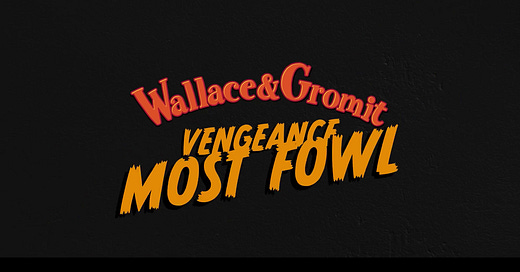It’s unbelievable to me that “Wallace and Gromit” hasn’t had a proper feature film since 2005’s delightful “Curse of the Were-Rabbit.”
At this point, I can measure out my life by the W&G output: I was a kid when the early shorts came out, a teenager when the third short called "A Close Shave” appeared, and then an early adult with “Were-Rabbit.”
Creator Nick Park, one of my favorite living filmmakers, presumably hasn’t cashed in on the franchise’s appeal as much as he could. Otherwise, like the “Despicable Me” fare, we’d be seeing Wallace’s wacky new inventions every other year.
So for those reasons, I treasure the new feature now on Netflix (as of January 3, 2025), “Vengeance Most Fowl.”
As the title suggests, this one is a treasure-trove of dad-jokes, a constant repetition of serious setups and cheeky payoffs. The feature pays homage to Bond movies, the Pink Panther series, and — in classic Park style — “Aliens” and “The Matrix.”
What I love about this series is that, while easily digestible, nothing here is easy at all. Even with technological advances, the stop-motion animation must still be a chore. More importantly, the shot-making is still as grand as ever. Park and his crew always go for the most meticulous details, the most elaborate setups, when most other moviemakers would take shortcuts.
“Vengeance Most Fowl” is more or less a sequel to the great 1993 short “The Wrong Trousers,” which features the series’ best villain: a villainous penguin deadset on stealing the amazing blue diamond from a museum.
“Fowl” begins with the penguin thrown in the slammer, which is of course a zoo. With the blankest of movie stares — he’s got just two black eyes against a penguin face — the villain expresses all he needs to. He wants to get out and get that diamond again, while getting vengeance on his nemesis, Wallace.
Meanwhile, Wallace is off naively inventing gadgets that take on a life of their own. In this movie he makes the Norbot, a garden-gnome robot capable of taking care of everybody’s handy-dandy gardening and outdoor tasks.
This majorly annoys the dog Gromit, a conscientious and empathetic beagle who lovingly tends the pair’s garden. When Wallace’s Norbot gets out into that space, he properly hacks it up into an efficient, modernist hellscape.
Naturally, the neighbors cheer. Here’s an invention that can save them time and money! And Wallace, hard up for cash, can hire out his Norbot to everyone. It’s a technological win-win for all except Gromit.
But the penguin, alas, the penguin. In the zoo, he somehow hacks Wallace’s Norbot, switching the robot’s protocol from GOOD to EVIL!
That results in predictable wackiness, including the Norbot building his own army of boot-stomping Norbot clones, which are out to build something that might help the penguin escape so that he can pull off his master plan.
Probably the whole movie’s idea about modern technology is encapsulated in Wallace’s early lines: “embracing tech makes our lives better . . . as long as it knows who’s boss.”
That means in a screwball stop-motion feature that chaos will reign for a good long time, since the hacked Norbot won’t know who’s boss at all, except the penguin.
I laughed a lot at this one, including the reveal of where exactly the blue diamond is, which, for a long time, everybody thinks is in the proper hands of the police. As usual, the cops have a vegetable joke or three coming to them, regarding the diamond’s whereabouts.
Best of all are the Norbots, designed perfectly to capture the Seven-Dwarves workaholic spirit that they embody. When Gromit has to put up with his Norbot’s attempt at charging, everybody watching will get the joke because we live them daily. For example, the thing glows bright while charging and announces itself repeatedly, even while Gromit tries to go to sleep.
These bots look pretty happy at glance, except they have the touch of the psychotic, the exact right touch. It’s not clear if Wallace has made a helpful timesaver of a device or has ushered in the Skynet Singularity.
It all depends on whether the bots know who’s boss.
Meanwhile, the penguin disguises itself once again as, of all things, a chicken. Later, it becomes a nun, fooling the police with its black-and-white exterior. That sets up a great gag when the “nun” disrobes. Wallace of course is oblivious to everything, including a penguin wearing a red glove on its head trying to pass itself off as a chicken.
Probably, reader, it’s worth watching “The Wrong Trousers” again, the short film that “Vengeance Most Fowl” relies on. The new movie will catch you up to speed on what you missed or forgot in “Trousers,” yet it’s also worth looking at how much the series has visually and sonically evolved since 1993, when “Trousers” came out.
Because I have no doubt that Nick Park himself is a bit of a Wallace, a technological tinkerer interested in making his life easier, which can make his craft better.
He’s still the stop-motion champion of the cinema these days, and that makes him, in my view, one of the all-time great animators.









